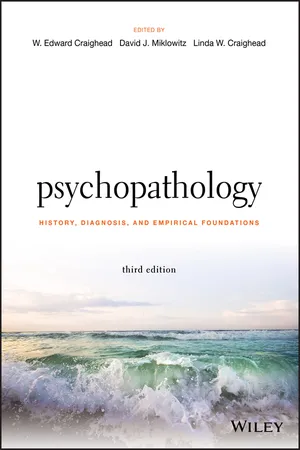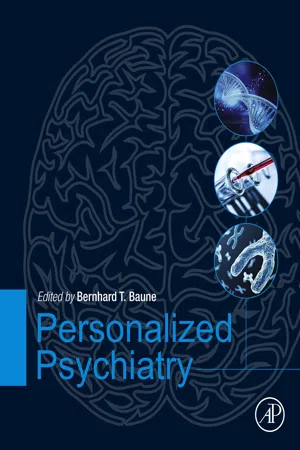Psychology
Gunderson et al 2013 study
The Gunderson et al 2013 study investigated the impact of mindfulness-based cognitive therapy (MBCT) on individuals with a history of depression. The study found that MBCT was effective in reducing the risk of depressive relapse, particularly for those with a history of childhood trauma. These findings suggest that MBCT may be a valuable intervention for preventing recurrent depression in at-risk populations.
Written by Perlego with AI-assistance
Related key terms
Related key terms
1 of 4
Related key terms
1 of 3
4 Key excerpts on "Gunderson et al 2013 study"
- eBook - ePub
Psychopathology
History, Diagnosis, and Empirical Foundations
- W. Edward Craighead, David J. Miklowitz, Linda W. Craighead, W. Edward Craighead, David J. Miklowitz, Linda W. Craighead(Authors)
- 2017(Publication Date)
- Wiley(Publisher)
The borderline diagnosis had been largely ignored from Stern's time until the late 1960s. After the psychoanalyst Otto Kernberg began to offer clinically rich and theoretically insightful perspectives on the disorder (Kernberg, 1967), interest began to increase. Around the same time, Grinker, Werble, and Drye (1968) published the first empirical study of the borderline syndrome.A third key event was the highly influential literature review conducted by Gunderson and Singer (1975). This integrated the earlier descriptive efforts and attempted to provide diagnostic criteria for BPD. By 1980, the construct of borderline personality disorder was considered to be sufficiently well developed and valid to warrant inclusion in the most important revision of the diagnostic nomenclature—the DSM‐III (APA, 1980; Spitzer, Endicott, & Gibbon, 1979; Spitzer, Forman, & Nee, 1979). BPD has since become the most researched of all the personality disorders.One other historical note warrants mention. Just before BPD was added to the DSM‐III, U.S. psychiatrists were polled about whether an alternative name for the disorder should be considered. More specifically, Spitzer, Endicott, and Gibbon (1979) proposed that the name “unstable personality disorder” be substituted. However, a majority of clinicians felt inclined to retain the familiar term, borderline personality.As Paris (1999) has noted, however, this decision may have been a mistake. The term borderline is strongly linked to the psychoanalytic tradition. This may have led to the disorder being less accepted by clinicians from other perspectives. The term borderline is also inherently confusing because it is not immediately clear what border is being referred to. Indeed, Akiskal et al. (1985) have described borderline as “an adjective in search of a noun.” These factors may have created resistance to accepting the disorder—resistance that, until relatively recently, was especially strong in Europe (e.g., Tyrer, 1999). Although BPD is now included in the ICD‐10, the more descriptive term emotionally unstable disorder - eBook - ePub
Personality Disorders
Elements, History, Examples, and Research
- Vera Sonja Maass(Author)
- 2019(Publication Date)
- Praeger(Publisher)
The relationship between sexual abuse and borderline personality disorder has perhaps received the most attention. Upward of 70 percent of patients reported a history of that type of abuse. These findings led to the conclusion that trauma is a major etiological factor for borderline personality disorder. Other evidence, however, does not support such a conclusion. A meta-analysis of 21 studies involving 2,479 individuals revealed only a moderate association between childhood sexual abuse and borderline personality disorder. The conclusion of the literature reviews suggested that about one-third of patients with borderline personality disorder reported severe abuse involving an incestuous perpetrator, severe sexual abuse, and high frequency or long duration.It has been pointed out that empirical research revealing the broad array of features delineating BPD meet the criteria for other personality disorders as well. This convergence has been used to suggest that the DSM-IV’s BPD is an artificially circumscribed category to distinguish it from other diagnoses. Therefore, it appears that the disorder may be more an indication of severe personality dysfunction than a distinct diagnostic entity (Berkelowitz & Tarnopolsky, 1993).Although most personality disorder research has focused on this category, some criticism has been expressed, stating that as long as categories of mental disorder are based on clinical observation instead of on biological markers, such as blood tests or imaging findings, validity will remain weak (Paris, 2008).John Gunderson at McLean Hospital developed the Diagnostic Interview for Borderline Patients (DIB), which was later revised by Mary Zanarini (DIB-R) (Zanarini et al., 1989). It is a semistructured interview assessing people’s conditions in the four domains of BPD pathology (affective, cognitive, impulsive, and interpersonal). Each domain is scored separately with a maximum score of 10, and 8/10 being the cutoff for BPD. - eBook - ePub
Through The Looking Glass
Women And Borderline Personality Disorder
- Dana Becker(Author)
- 2019(Publication Date)
- Routledge(Publisher)
Chapter 3 ) to his description of the debate as one in which the notion of “earlier” is equated with “deeper” or “more fundamental.” Theories of the present decade, however, are not immune from these basic confusions. For example, Gunderson trusts in the “earliness” of onset of borderline traits (Gunderson & Sabo, 1993) to help differentiate borderline from posttraumatic conditions: “If certain traits (namely, borderline criteria 5, 6, and 8 and the newly proposed criterion 9) … are not documented parts of enduring patterns, they could be considered symptoms rather than personality traits. Their use as criteria for a personality disorder rests on their having an early onset and their being persistent qualities that endure across many situations” (p. 21).Gunderson recommends that clinicians perform extensive and thorough histories in order to ascertain the “earliness” of the onset of difficulties. Like many studying borderline psychopathology today, he discusses the influence of traumata, separations, and neglect in the creation of borderline symptoms. At the same time, however, he subscribes to the idea that the earlier the trauma, the more severe it is and the more productive of characterological effects, not to mention the fact that “beyond … observable reactions, … traumas evoke immature or primitive defenses that can persist well after the stress is over” (p. 22). Discussions of the relationship of situational factors in the development of BPD are not infrequently accompanied by this sort of unquestioning acceptance of a notion of “primitive defenses” that tips its hat to—or, more accurately perhaps, borrows the hat from— Kernberg. Gunderson’s insistence upon distinguishing PTSD symptoms from borderline traits - eBook - ePub
- Bernhard Baune(Author)
- 2019(Publication Date)
- Academic Press(Publisher)
Chapter 19Genomics of borderline personality disorder
Fabian Streita ; Lucía Colodro-Condeb ; Alisha S.M. Halla ; Stephanie H. Wittaa Department of Genetic Epidemiology in Psychiatry, Central Institute of Mental Health, Medical Faculty Mannheim, University of Heidelberg, Mannheim, Germanyb Genetics & Computational Biology Department, QIMR Berghofer Medical Research, Brisbane, QLD, AustraliaAbstract
Borderline personality disorder (BPD) is comprised of a heterogeneous range of symptoms, including impairment in affect regulation and interpersonal relationships. Dimensional, as well as categorical, diagnostic approaches have been suggested to assess BPD. Twin and family studies indicate that genetic factors contribute to BPD and borderline personality features, and that these are partially shared with the factors influencing personality traits and other psychiatric disorders. The genome-wide association studies that have investigated borderline personality are in line with these observations. However, substantially larger studies are needed to identify the underlying molecular genetic mechanisms of borderline personality. Future genetic research integrating different levels of biological and clinical data has the potential to help guide and monitor personalized diagnosis and treatment. This chapter presents the current state of genetic research into BPD and explores the future contribution of genetic research to a personalized diagnosis and treatment process.Keywords
Borderline personality disorder; Borderline personality features; Genomics; Epigenomics; Comorbidity; Subphenotype; Personalized psychiatry1 Clinical aspects of borderline personality disorder
Borderline personality disorder (BPD) is a mental illness marked by an ongoing pattern of varying self-image, moods, and behavior. The median prevalence of BPD is around 3% (Tomko, Trull, Wood, & Sher, 2014 ), and BPD patients constitute a relatively large portion of the population receiving inpatient (20%; American Psychiatric Association, 2013 ) and outpatient (10%; Zimmerman, Rothschild, & Chelminski, 2005 ) mental health care. Approximately 75% of patients diagnosed with BPD are women, and the prevalence of BPD may decrease with age (American Psychiatric Association, 2013
Index pages curate the most relevant extracts from our library of academic textbooks. They’ve been created using an in-house natural language model (NLM), each adding context and meaning to key research topics.
Explore more topic indexes
Explore more topic indexes
1 of 6
Explore more topic indexes
1 of 4



